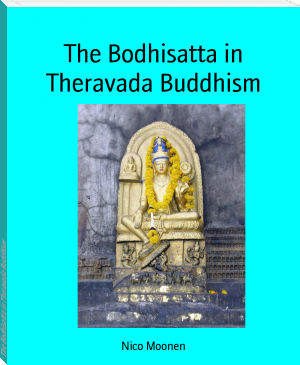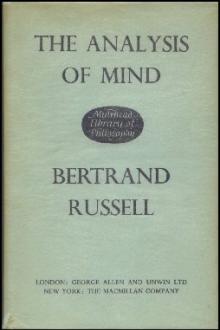Buddhism and Buddhists in China by Lewis Hodous (best way to read e books .TXT) 📕

But such mandates were as unsuccessful as other similar schemes havebeen. In the third century A. D. after the Han dynasty had ended, Chinawas broken up into several small kingdoms which contended for supremacy,so that for about four hundred years the whole country was in a state ofdisunion. One of the strong dynasties of this period, the Northern Wei(386-535 A. D.), was distinctly loyal to Buddhism. During itscontinuance Buddhism prospered greatly. Although Chinese wer
Read free book «Buddhism and Buddhists in China by Lewis Hodous (best way to read e books .TXT) 📕» - read online or download for free at americanlibrarybooks.com
- Author: Lewis Hodous
- Performer: -
Read book online «Buddhism and Buddhists in China by Lewis Hodous (best way to read e books .TXT) 📕». Author - Lewis Hodous
VII
BUDDHISM AND THE FUTURE LIFE
Before the advent of Buddhism the Chinese had only a vague idea regarding life after death. The Land and Water Classic mentions the Tu Shuo mountain in the Eastern Sea, under which spirits of the dead live, the entrance guarded by two spirits, Sh�n Tu and Y� Lei, who are in general control of the demons. In some parts of China the names or pictures, of these spirits are placed on the doors of a house to guard it. The Taoists early developed the idea of a western paradise presided over by the Queen of the West, located at first in the K’un Lun mountains and later in the islands of the Eastern Sea. This heaven, however, was limited to Taoist hermits and mystics. Buddhism made a complete purgatory and heaven known to every one in China.
1. The Buddhist PurgatoryThis is really Buddhism’s most noteworthy addition to China’s religious equipment; Buddhism lays much stress upon the experiences of a soul immediately after death. Its punishments are well known to every individual. The temple of the City Guardian found in every walled city has a replica of the court in purgatory over which he presides. In the temples of T’ai Shan there is an elaborate exhibit of the tortures inflicted on culprits in purgatory. Every funeral service conducted by Buddhists or Taoists is intended to conduct the soul of the dead through purgatory and pictures vividly the progressive experiences from the first seventh day to the seventh seventh day. On the the seventh month, on the fifteenth day [about August] a special service is held for the souls of the dead in purgatory. Furthermore, every community has a general service [about October] for the souls of those who died a violent death or who have no one to look after them. During the war many services were thus held for those who died on the battlefields of Europe. At such services the scenes in purgatory are vividly portrayed by pictures and figures. The temples distribute tracts with pictures of purgatory so that women may see them and understand. On the stage are often acted powerful plays whose scenes are laid in Hades. This propaganda is perhaps the most efficient of its kind.
Purgatory is depicted as consisting of ten courts each surrounded by small hells, where the soul undergoes punishment and cleansing. The fifth court, which may be taken as an example of the other courts, is in charge of Yen Lo or Yama. Yama was once in charge of the first court, but his tender heart pitied the souls who came before him and sent them back to earth. Because of this leniency he was placed in charge of the fifth court.
When a soul has passed through the first four courts and it has been discovered that there is no good conduct to its credit, it is led to the fifth court and examined every seven days regarding past conduct. In order to get back to the world of men, it eagerly promises to complete various unfinished vows, such as to repair monasteries, schools, bridges, or roads, to clean wells, to deepen rivers, to distribute good books, to release animals, to take care of aged parents, or to bury them suitably. But it is plainly told that the gods know its artifices, and that now these unfinished tasks can never be completed. The gods have reached the unanimous opinion that no injustice is being done. Accordingly there is no appeal, but each soul is led by attendants with bulls’ heads and horses’ faces to a tower whence they may see their native village. Its front is in the shape of a bow with a perimeter of twenty-seven miles; its height is four hundred and ninety feet. It is guarded by walls of sword trees.
Good men, whose deeds of omission are balanced by the good they have done, return to life. Only souls judged to be evil see their village from this tower. These can see their own families moving about, and can hear their conversation. They realize how they disobeyed the teachings of their elders. They see that the earthly goods for which they have struggled are of no value. Their plottings rise up with lurid reality. They see how they planned a new marriage although already married, how they appropriated fields, state property, and falsified accounts, putting the blame on persons who were dead. While they observe their village they behold their erstwhile friends touch their coffin and inwardly rejoice. They hear themselves called selfish and insincere. But their punishment does not stop here. They behold their children punished by magistrates, their women afflicted with strange diseases, their daughters ravished, their sons led astray, their property taken away, the ancestral house burned and their business ruined. From this tower all passes before them as a lurid dream and they are stricken in heart.
About the fifth court are sixteen small hells where the soul is punished. In each one are stakes buried in the ground and fierce animals. The hands and feet of the guilty one are bound to a stake, his body is opened with small knives, and his heart and intestines quickly devoured.
In each of these sixteen hells is a certain type of sinner: (1) Those who do not reverence the gods and demons and who doubt the existence of rewards and punishments; (2) those who hurt and kill living beings; (3) those who break their vows to do good; (4) those who resort to heterodox practices and vainly hope to attain eternal life; (5) those who upbraid good men, fear the wicked and hate men because they do not die speedily; (6) those who strive with other people and then put the blame upon them; (7) men who force women; and women who seduce young men, and all who have libidinous desires; (8) those who gain profit for themselves by injuring others; (9) the stingy and those who absolutely disregard others, whether alive or dead, giving them no help in dire need, when they can do so without injury to themselves; (10) those who steal and put the crime upon others; (11) those who requite favors with hate; (12) those whose hearts are perverse and poisonous, who instigate others to do wrong even if they may not have carried out their suggestion; (13) those who tempt others by deceit; (14) those who involve others in their squabbles and in gambling and then themselves win out; (15) those who stubbornly persist in their false ideas, do not repent, and slander others; (16) those who hate good and virtuous men.
Besides these sixteen sorts of sinners the fifth court deals with other types of wicked people; those who do not believe in rewards and punishments after death, who hinder good causes, who burn incense without a sincere heart, speak of the sins of others, who burn books that urge men to be good and worship the Great Dipper, but persist in eating meat; those who hate men; who repeat sutras and incantations, and take part in religious ceremonies, but do not fast beforehand; who slander the Buddhist and Taoist religions; who know how to read, but refuse to read the ancient and modern exhortations regarding rewards and punishments; who dig into graves and destroy their marks, who purposely set fire to trees and underbrush, or are careless with fire in their own houses; who shoot arrows at animals with the intent, to kill; who urge and tempt the sick and weak to enter into contests of any kind with themselves; who throw tiles and stones over neighboring walls, poison fish in the river, fire guns, or make nets or traps for birds; who sow salt on the ground, who do not bury dead eats and snakes very deep and thus cause death to those who dig; who cause men to dig the frozen ground in winter or spring (the vapors of earth chill such diggers to death); who tear down adjoining walls and compel their neighbors to move the kitchen stove; who appropriate public highways, lands, close wells and stop gutters.
Those who have committed any of the above sins are taken, to the tower whence they can see their own village and then are consigned to the great crying hell, R�urava, that is, the fourth of the Buddhist hot hells. [Footnote: Buddhism distinguishes hot and cold hells. In a country like India severe cold is a serious torture.] Thence they go to their respective small hells. When their time has expired, they are examined in order to see whether they have any other sins which need punishment.
Those who have committed any of the above sins may not only escape punishment, but may have their punishment in the sixth court lessened, if they fast regularly on the eighth day of the first month and take a vow not to commit these sins. Some sins, however, cannot be arranged for in such a way, such as the killing of living beings and hurting them; the associating with heretics; committing fornication with women and then poisoning them; committing adultery, violence, envy, or injuring the good name of others; stealing, requiting favors with hatred, and hearing exhortation but not repenting. These are major sins.
2. Its Social ValueThe social value of purgatory is quite plain from the description of the fifth court and of the sinners who are punished therein. Purgatory is the social mirror of China, wherein the consequences of all unsocial acts are pictured in such a vivid way as to deter the individual from committing them. It is effective in China, not only because of the realistic presentation, but because the opinion of the community is against such acts and in favor of repressing them on every occasion.
3. The Buddhist Heaven.
Buddhism brought into China not only a fully developed purgatory but also a heaven which all may enter. The sovereign of the western heaven is Amit�bha (or in Chinese O-mi-to-fo), with whom Kuan Yin, the goddess of Mercy, is usually associated. Amit�bha is explained as meaning “boundless age.” The original meaning is “boundless light,” which suggests a Persian origin with Mannichean influences. The translations of the Amit�bha sutras were wholly made by natives of central Asia.
Amit�bha is one of the thousand Buddhas; he is regarded as the reflex of Sakyamuni and is connected also in his earthly incarnation with a monk called Dharm�kara. This monk desired to become a Buddha. This wish he presented to L�k�s’varar�ja asking him to teach him as to what a Buddha and a Buddha country ought to be. L�k�s’varar�ja imparted this knowledge. Then the monk after meditation returned having made forty-eight vows that he would not become a Buddha, until all living beings should attain salvation in his heaven.
The eighteenth vow expresses his ideal:
“O Bhagavat, if





Comments (0)